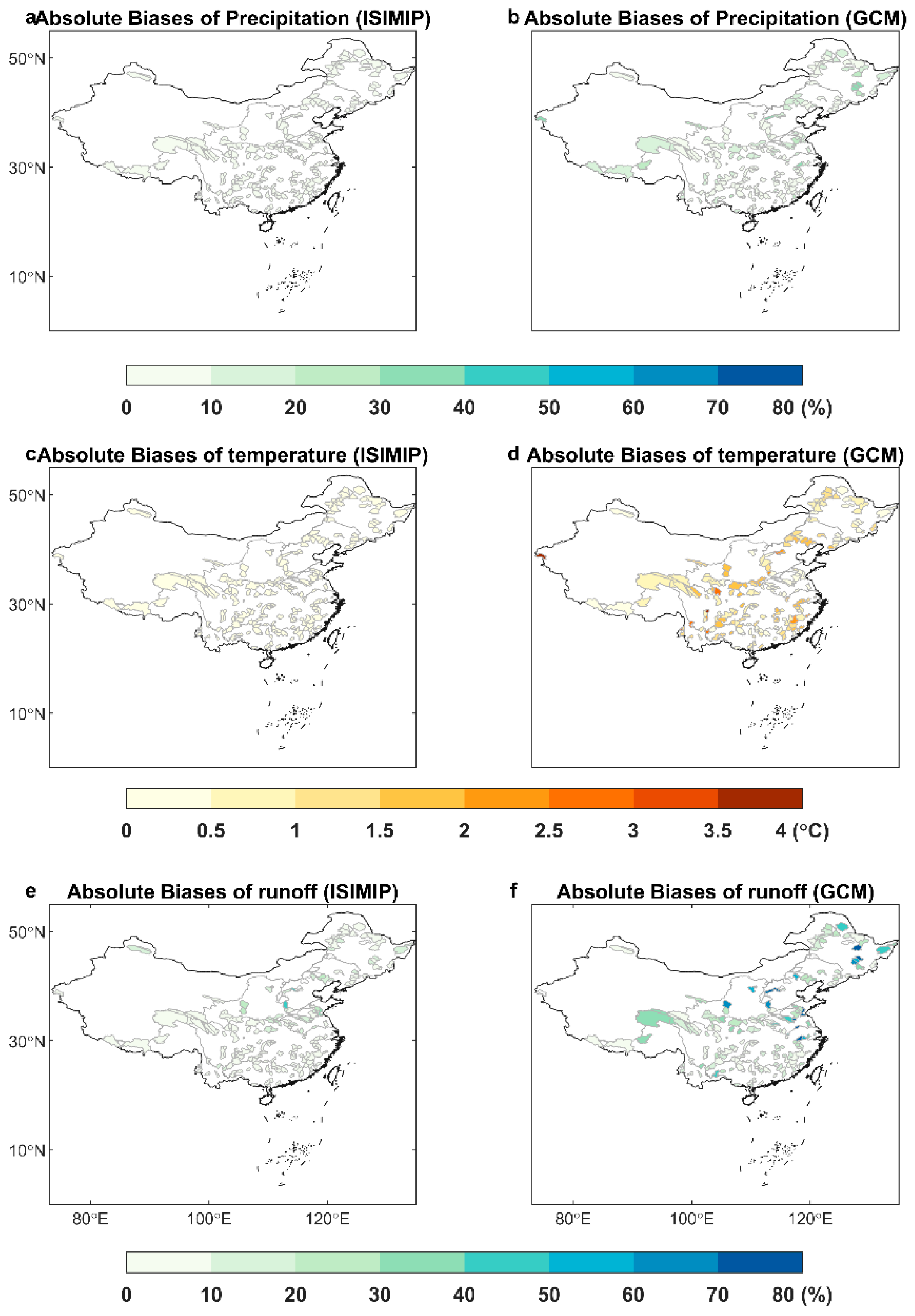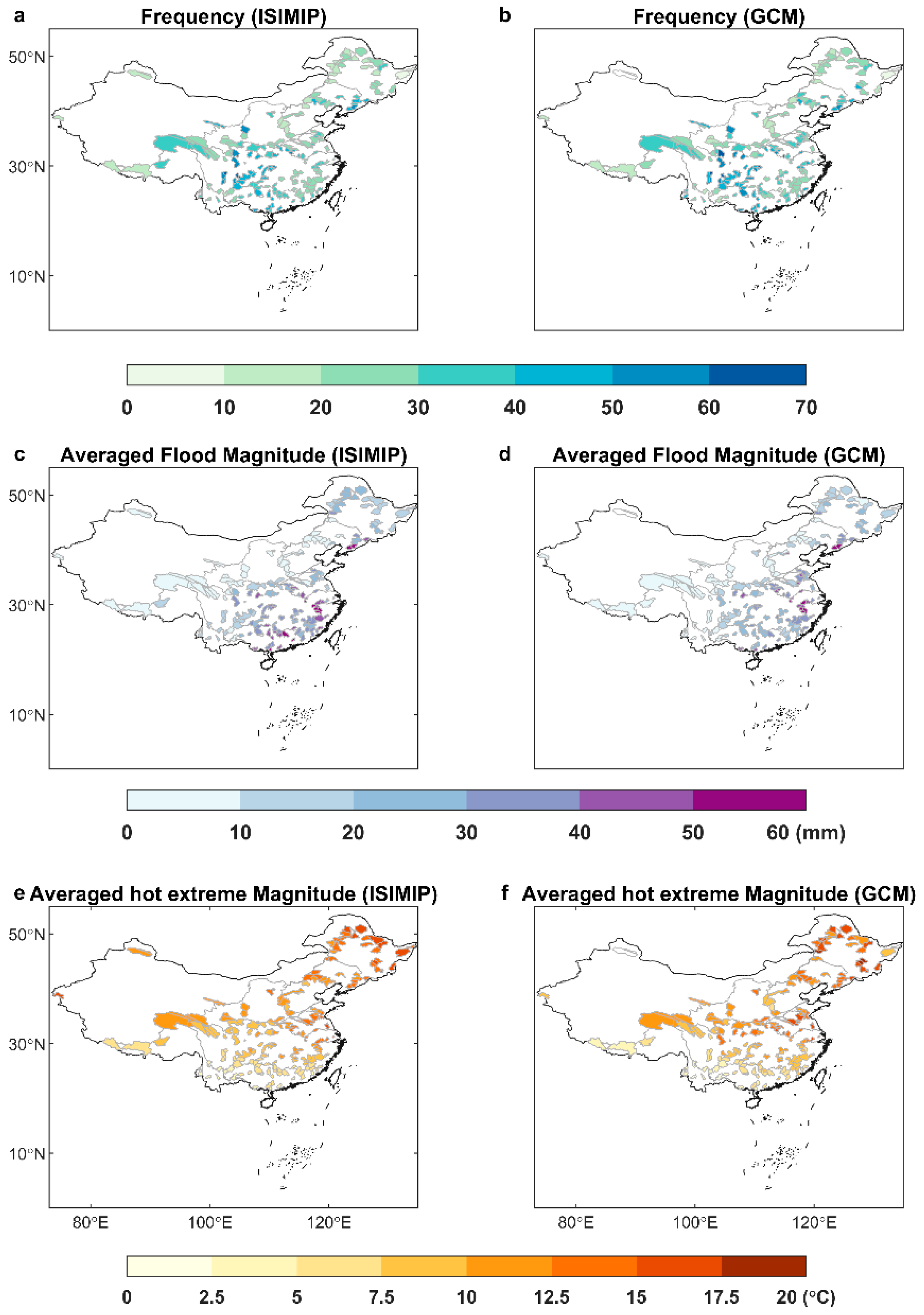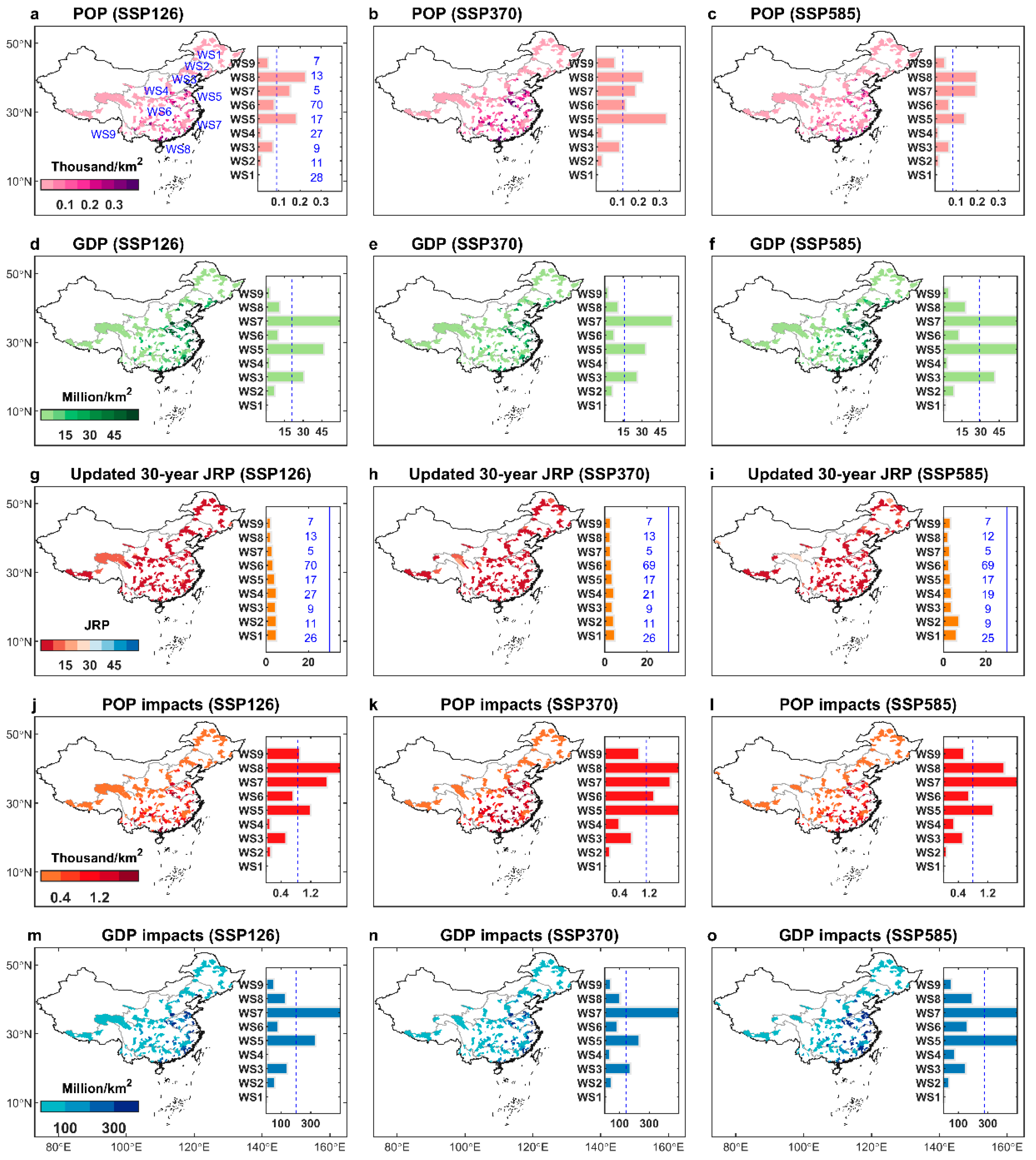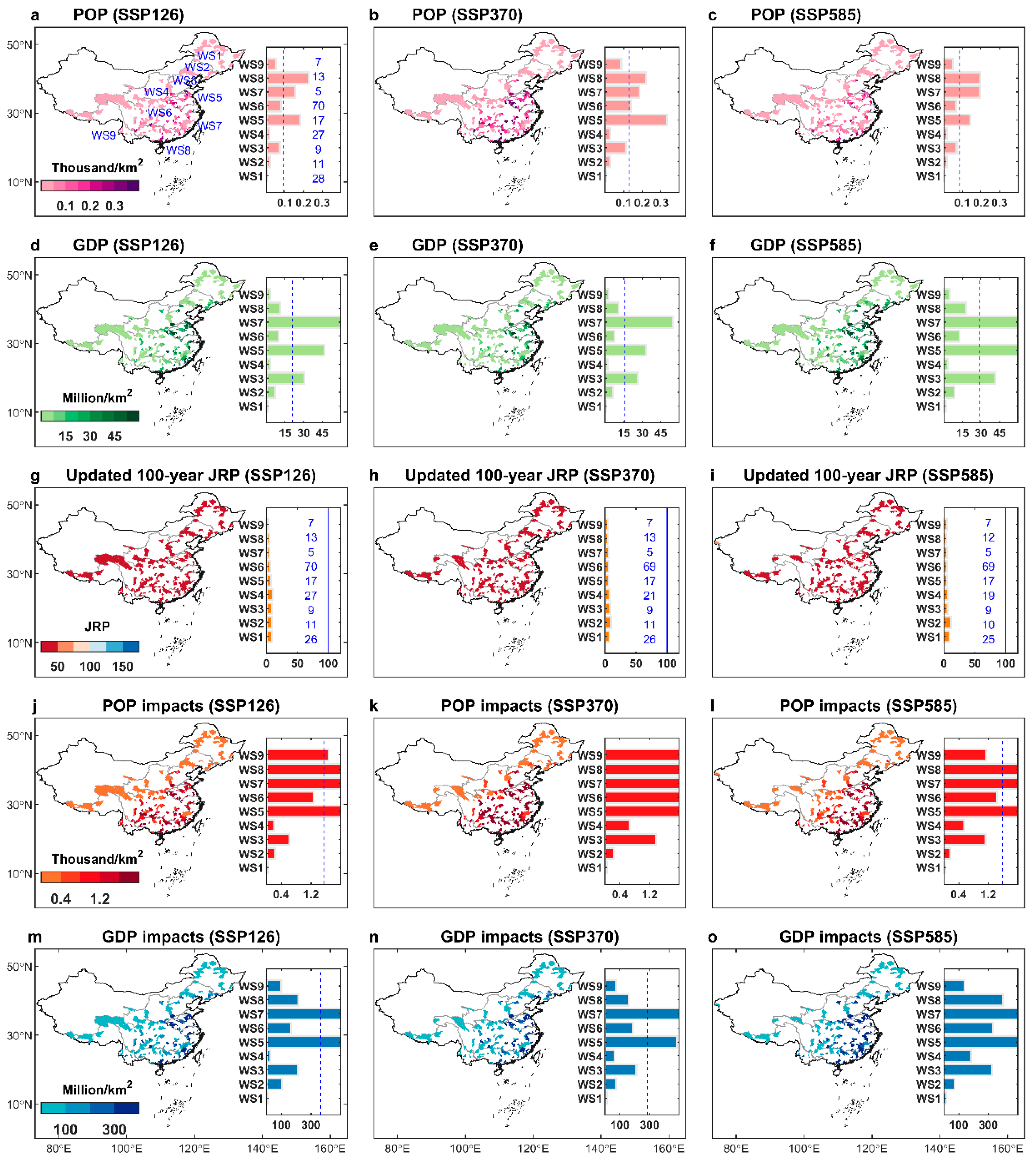Severe Socioeconomic Exposures Due to Enhanced Future Compound Flood-Heat Extreme Hazards in China
Abstract
:Supplementary Materials
Author Contributions
Funding
Data Availability Statement
Acknowledgments
Conflicts of Interest
References
- Hirmas, D.R.; Giménez, D.; Nemes, A.; Kerry, R.; Brunsell, N.A.; Wilson, C.J. Climate-induced changes in continental-scale soil macroporosity may intensify water cycle. Nature 2018, 561, 100–103. [Google Scholar] [CrossRef] [PubMed]
- Barnett, T.P.; Adam, J.C.; Lettenmaier, D.P. Potential impacts of a warming climate on water availability in snow-dominated regions. Nature 2005, 438, 303–309. [Google Scholar] [CrossRef] [PubMed]
- Xiong, J.; Yin, J.; Guo, S.; He, S.; Chen, J. Annual runoff coefficient variation in a changing environment: A global perspective. Environ. Res. Lett. 2022, 17, 064006. [Google Scholar] [CrossRef]
- Fischer, E.M.; Knutti, R. Observed heavy precipitation increase confirms theory and early models. Nat. Clim. Chang. 2016, 6, 986–991. [Google Scholar] [CrossRef]
- Yin, J.; Gentine, P.; Zhou, S.; Sullivan, S.C.; Wang, R.; Zhang, Y.; Guo, S. Large increase in global storm runoff extremes driven by climate and anthropogenic changes. Nat. Commun. 2018, 9, 1–10. [Google Scholar] [CrossRef] [PubMed] [Green Version]
- Budhathoki, A.; Tanaka, T.; Tachikawa, Y. Correcting streamflow bias considering its spatial structure for impact assessment of climate change on floods using d4PDF in the Chao Phraya River Basin, Thailand. J. Hydrol. Reg. Stud. 2022, 42, 101150. [Google Scholar] [CrossRef]
- Diffenbaugh, N.S.; Swain, D.L.; Touma, D. Anthropogenic warming has increased drought risk in California. Proc. Natl. Acad. Sci. USA 2015, 112, 3931–3936. [Google Scholar] [CrossRef] [PubMed] [Green Version]
- Ganguli, P.; Singh, B.; Reddy, N.N.; Raut, A.; Mishra, D.; Das, B.S. Climate-catchment-soil control on hydrological droughts in peninsular India. Sci. Rep. 2022, 12, 1–14. [Google Scholar] [CrossRef]
- Gu, L.; Chen, J.; Xu, C.Y.; Kim, J.S.; Chen, H.; Xia, J.; Zhang, L. The contribution of internal climate variability to climate change impacts on droughts. Sci. Total Environ. 2019, 684, 229–246. [Google Scholar] [CrossRef]
- Zhang, W.; Luo, M.; Gao, S.; Chen, W.; Hari, V.; Khouakhi, A. Compound hydrometeorological extremes: Drivers, mechanisms and methods. Front. Earth Sci. 2021, 9, 673495. [Google Scholar] [CrossRef]
- Imada, Y.; Watanabe, M.; Kawase, H.; Shiogama, H.; Arai, M. The July 2018 high temperature event in Japan could not have happened without human-induced global warming. Sola 2019, 15A, 8–12. [Google Scholar] [CrossRef] [Green Version]
- Sedlmeier, K.; Feldmann, H.; Schädler, G. Compound summer temperature and precipitation extremes over central Europe. Theor. Appl. Climatol. 2018, 131, 1493–1501. [Google Scholar] [CrossRef]
- Zhang, W.; Villarini, G. Deadly compound heat stress-flooding hazard across the central United States. Geophys. Res. Lett. 2020, 47, e2020GL089185. [Google Scholar] [CrossRef]
- Matthews, T.; Wilby, R.L.; Murphy, C. An emerging tropical cyclone–deadly heat compound hazard. Nat. Clim. Chang. 2019, 9, 602–606. [Google Scholar] [CrossRef] [Green Version]
- Lin, N. Tropical cyclones and heatwaves. Nat. Clim. Chang. 2019, 9, 579–580. [Google Scholar] [CrossRef]
- Gu, L.; Chen, J.; Yin, J.; Slater, L.J.; Wang, H.; Guo, Q.; Feng, M.; Qin, H.; Zhao, T. Global Increases in Compound Flood-Hot Extreme Hazards under Climate Warming. Geophys. Res. Lett. 2022, 49, e2022GL097726. [Google Scholar] [CrossRef]
- Stefanidis, S.; Alexandridis, V.; Theodoridou, T. Flood exposure of residential areas and infrastructure in Greece. Hydrology 2022, 9, 145. [Google Scholar] [CrossRef]
- Li, J.; Guo, P.; Sun, Y.; Liu, Z.; Zhang, X.; Pei, X. Population Exposure Changes to One Heat Wave and the Influencing Factors Using Mobile Phone Data—A Case Study of Zhuhai City, China. Sustainability 2022, 14, 997. [Google Scholar] [CrossRef]
- Theodosopoulou, Z.; Kourtis, I.M.; Bellos, V.; Apostolopoulos, K.; Potsiou, C.; Tsihrintzis, V.A. A Fast Data-Driven Tool for Flood Risk Assessment in Urban Areas. Hydrology 2022, 9, 147. [Google Scholar] [CrossRef]
- Ge, Y.; Dou, W.; Liu, N. Planning resilient and sustainable cities: Identifying and targeting social vulnerability to climate change. Sustainability 2017, 9, 1394. [Google Scholar] [CrossRef]
- Peters, G.P. The best available science to inform 1.5 C policy choices. Nat. Clim. Chang. 2016, 6, 646–649. [Google Scholar] [CrossRef] [Green Version]
- Liu, W.; Sun, F.; Lim, W.H.; Zhang, J.; Wang, H.; Shiogama, H.; Zhang, Y. Global drought and severe drought-affected populations in 1.5 and 2 C warmer worlds. Earth Syst. Dyn. 2018, 9, 267–283. [Google Scholar] [CrossRef] [Green Version]
- Lange, S. Trend-preserving bias adjustment and statistical downscaling with ISIMIP3BASD (v1.0). Geosci. Model Dev. 2019, 12, 3055–3070. [Google Scholar] [CrossRef] [Green Version]
- Riahi, K.; Van Vuuren, D.P.; Kriegler, E.; Edmonds, J.; O’neill, B.C.; Fujimori, S.; Bauer, N.; Calvin, K.; Dellink, R.; Fricko, O.; et al. The shared socioeconomic pathways and their energy, land use, and greenhouse gas emissions implications: An overview. Glob. Environ. Chang. 2017, 42, 153–168. [Google Scholar] [CrossRef] [Green Version]
- Lange, S.; Menz, C.; Gleixner, S.; Cucchi, M.; Weedon, G.P.; Amici, A.; Bellouin, N.; Schmied, H.M.; Hersbach, H.; Buontempo, C.; et al. WFDE5 over land merged with ERA5 over the ocean (W5E5 v2. 0). Data Publ. 2021. [Google Scholar] [CrossRef]
- Janssens, C.; Havlík, P.; Krisztin, T.; Baker, J.; Frank, S.; Hasegawa, T.; Leclère, D.; Ohrel, S.; Ragnauth, S.; Schmid, E.; et al. Global hunger and climate change adaptation through international trade. Nat. Clim. Chang. 2020, 10, 829–835. [Google Scholar] [CrossRef]
- Zhao, R.J. The Xinanjiang model applied in China. J. Hydrol. 1992, 135, 371–381. [Google Scholar]
- Perrin, C.; Michel, C.; Andreassian, V. Improvement of a parsimonious model for streamflow simulation. J. Hydrol. 2003, 279, 275–289. [Google Scholar] [CrossRef]
- Bergström, S.; Forsman, A. Development of a conceptual deterministic rainfall-runoff mode. Nord. Hydrol. 1973, 4, 240–253. [Google Scholar] [CrossRef]
- Martel, J.L.; Demeester, K.; Brissette, F.P.; Arsenault, R.; Poulin, A. HMET: A simple and efficient hydrology model for teaching hydrological modelling, flow forecasting and climate change impacts. Int. J. Eng. Educ. 2017, 33, 1307–1316. [Google Scholar]
- Chiew, F.H.S.; Peel, M.C.; Western, A.W. Application and testing of the simple rainfall-runoff model SIMHYD. In Mathematical Models of Small Watershed Hydrology and Applications; Water Resources Publications: Lone Tree, CO, USA, 2002; pp. 335–367. [Google Scholar]
- Jiang, T.; Jing, Z.; Cao, L.-G.; Wang, Y.-J.; Su, B.; Jing, C.; Wang, R.; Gao, C. Projection of national and provincial economy under the shared socioeconomic pathways in China. Adv. Clim. Chang. Res. 2018, 14, 50. [Google Scholar]
- Su, B.; Huang, J.; Fischer, T.; Wang, Y.; Kundzewicz, Z.W.; Zhai, J.; Sun, H.; Wang, A.; Zeng, X.; Wang, G.; et al. Drought losses in China might double between the 1.5° and 2.0° warming. Proc. Natl. Acad. Sci. USA 2018, 115, 10600–10605. [Google Scholar] [CrossRef] [PubMed] [Green Version]
- Gu, L.; Chen, J.; Yin, J.; Sullivan, S.C.; Wang, H.-M.; Guo, S.; Zhang, L.; Kim, J.-S. Projected increases in magnitude and socioeconomic exposure of global droughts in 1.5° and 2° warmer climates. Hydrol. Earth Syst. Sci. 2020, 24, 451–472. [Google Scholar] [CrossRef]
- Yin, J.; Slater, L.; Gu, L.; Liao, Z.; Guo, S.; Gentine, P. Global increases in lethal compound heat stress: Hydrological drought hazards under climate change. Geophys. Res. Lett. 2022, 49, e2022GL100880. [Google Scholar] [CrossRef]
- Liao, Z.; Chen, Y.; Li, W.; Zhai, P. Growing threats from unprecedented sequential flood-hot extremes across China. Geophys. Res. Lett. 2021, 48, e2021GL094505. [Google Scholar] [CrossRef]
- Wu, S.; Chan, T.O.; Zhang, W.; Ning, G.; Wang, P.; Tong, X.; Luo, M. Increasing compound heat and precipitation extremes elevated by urbanization in South China. Front. Earth Sci. 2021, 475, 636777. [Google Scholar] [CrossRef]




Publisher’s Note: MDPI stays neutral with regard to jurisdictional claims in published maps and institutional affiliations. |
© 2022 by the authors. Licensee MDPI, Basel, Switzerland. This article is an open access article distributed under the terms and conditions of the Creative Commons Attribution (CC BY) license (https://creativecommons.org/licenses/by/4.0/).
Share and Cite
Li, H.; Gu, Z.; Chen, J.; Yin, J.; Gu, L. Severe Socioeconomic Exposures Due to Enhanced Future Compound Flood-Heat Extreme Hazards in China. Atmosphere 2022, 13, 2089. https://doi.org/10.3390/atmos13122089
Li H, Gu Z, Chen J, Yin J, Gu L. Severe Socioeconomic Exposures Due to Enhanced Future Compound Flood-Heat Extreme Hazards in China. Atmosphere. 2022; 13(12):2089. https://doi.org/10.3390/atmos13122089
Chicago/Turabian StyleLi, Haochuan, Ziye Gu, Jie Chen, Jiabo Yin, and Lei Gu. 2022. "Severe Socioeconomic Exposures Due to Enhanced Future Compound Flood-Heat Extreme Hazards in China" Atmosphere 13, no. 12: 2089. https://doi.org/10.3390/atmos13122089






